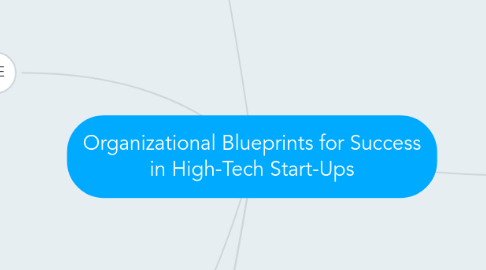
1. Implications of Blueprints for Organization-Building
1.1. Different for each model
2. Changing the Blueprint
2.1. Companies tend to become more bureaucratic over time
2.2. Only 11% changed from one pure model to another
2.3. 51% did not change their blueprint at all
2.4. 30% changed only one dimension
2.5. This shows that the model types seem to be meaningful and distinct from one another
2.6. Changes in blueprint often mean changes in senior management
2.6.1. Changes are more likely and more substantial when the CEO is not the founder anymore
2.7. Company that were focused on retainment tend to stick to their blueprint
2.8. Companies that were focused on delivering a product ASAP tend to change their blueprint substantially later on
3. Lessons
3.1. Risks and Costs of changing blueprint often outweigh benefits
3.1.1. Selecting the blueprint that is best for both the short and long term is often better than just taking the blueprint that is better at the offset
3.1.2. Founders have to decide which blueprint style to choose
3.1.2.1. Distinctive
3.1.2.1.1. Star and Commitment
3.1.2.2. Robust and Scalable
3.1.2.2.1. Engineering or Bureaucracy
3.2. Founders don't consider HR enough when planning the future of their business
3.2.1. Success of Commitment model could be because it went against the Valley spirit of the time
3.2.1.1. The relationships were hard to imitate and also sent out a signal of strength to other startups that they were able to maintain this style
3.3. Five blueprints have at least three properties that make them desirable for any HR blueprint
3.3.1. High Degree of Coherence / Internal Consistency
3.3.2. Types are Resonant and Salient in Silicon Valley
3.3.3. They reflect different logics of organizing within other institutions
3.3.3.1. Star Model resonates with academic science
3.3.3.2. Engineering resonates with the socialization that engineers receive in professional school
3.4. The older an organization is, the more different blueprints can be found throughout it
3.4.1. Avoiding this makes it easier to balance global consistency and local flexibility
3.4.2. When very different blueprints are expected to work together it will be a lot harder to achieve cooperation, lateral movement and healthy interdependence
3.5. Consider blueprints of two organizations when considering a merger, not afterwards to clean up
3.6. Put as much effort into building in the brand in your labor market as into the product market
4. Organizational Stability and Change
4.1. Path Dependent
4.1.1. Efforts changing the DNA of the company are destabilizing
4.2. Two predictions about the evolution and performance of young companies
4.2.1. Origins Matter
4.2.2. Change is Disruptive
4.3. These predictions are questionable in the fast paced environment of the Silicon Valley
5. THE EVIDENCE
5.1. Path set by founder is as important as path chosen by current CEO
5.2. Changes in blueprint are very destabilizing
5.2.1. Adverse effect on employee turnover
5.2.2. Adverse effect on bottom-line financial performance
5.2.3. Threat for survival
5.3. Administrative Overhead
5.3.1. Differs immensely between blueprint types
5.3.2. Initial choice of CEO has lasting impact
5.4. Employee Turnover
5.4.1. Shifting to bureaucracy or autocracy is especially disliked
5.4.2. CEO change has effect
5.4.2.1. Mostly though because new CEO changes blueprint
5.4.3. Better when new CEO changes blueprint rather than founder-CEO
5.4.3.1. Change by founder CEO is a strong reminder of how the company has left its roots
5.5. Organizational Performance
5.5.1. Commitment firms are first to go public
5.5.2. Non-types are last to go pubic
5.5.3. Create a sense an overarching goal of the company
5.5.3.1. IPO can be a milestone but should not be an end goal
5.5.4. Changing the blueprint negatively affects performance
5.5.4.1. Lower market growth
6. Organizational Models or Blueprints
6.1. Founders embrace very different mental models of the ideal organizational form for a tech startup
6.2. Vary among three main dimensions
6.2.1. Attachment
6.2.1.1. Love
6.2.1.2. Work
6.2.1.3. Money
6.2.2. Coordination / Control
6.2.2.1. Informal control through peers and Organizational Culture
6.2.2.2. Professional Control
6.2.2.3. Formal Procedures and Systems
6.2.2.4. Direct Oversight
6.2.3. Selection
6.2.3.1. Skills and experience needed to accomplish some immediate tasks
6.2.3.2. Long-term Potential
6.2.3.3. Values and Cultural Fit
6.3. Out of these 36 possible combinations, 5 are most frequent
6.3.1. Engineering
6.3.1.1. Attachement through Challenging Work
6.3.1.2. Peer control
6.3.1.3. Selection based on specific task abilities
6.3.2. Star
6.3.2.1. Attachement through Challenging Work
6.3.2.2. Control through autonomy and professionalism
6.3.2.3. Selection based on long-term potential
6.3.3. Commitment
6.3.3.1. Attachement through emotional ties
6.3.3.2. Peer control
6.3.3.3. Selection based on cultural fit
6.3.4. Bureaucracy
6.3.4.1. Attachement through challenging work and possibilities for development
6.3.4.2. Formal Control
6.3.4.3. Selection based on qualification for particular role
6.3.5. Autocracy
6.3.5.1. Attachement through money
6.3.5.2. Control and coordination through close personal oversight
6.3.5.3. Selection based on skills to perform pre-specified tasks
6.4. Although all companies are in a similar industry, of similar size and were founded at a similar time in the same location, there are many different configurations
6.4.1. This can be explained in part by the need for them to differentiate from one another
6.4.2. The only factor that seems to have a relationship is intended business strategy
6.4.2.1. Competition based on superior marketing, service or customer relationship are more likely to choose Commitment model

